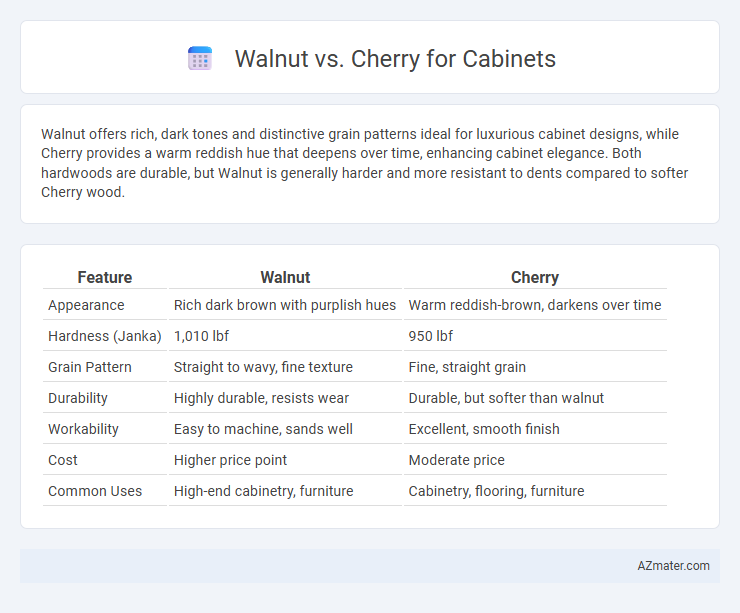Walnut offers rich, dark tones and distinctive grain patterns ideal for luxurious cabinet designs, while Cherry provides a warm reddish hue that deepens over time, enhancing cabinet elegance. Both hardwoods are durable, but Walnut is generally harder and more resistant to dents compared to softer Cherry wood.
Table of Comparison
| Feature | Walnut | Cherry |
|---|---|---|
| Appearance | Rich dark brown with purplish hues | Warm reddish-brown, darkens over time |
| Hardness (Janka) | 1,010 lbf | 950 lbf |
| Grain Pattern | Straight to wavy, fine texture | Fine, straight grain |
| Durability | Highly durable, resists wear | Durable, but softer than walnut |
| Workability | Easy to machine, sands well | Excellent, smooth finish |
| Cost | Higher price point | Moderate price |
| Common Uses | High-end cabinetry, furniture | Cabinetry, flooring, furniture |
Walnut vs Cherry Cabinets: An Overview
Walnut cabinets offer rich, dark tones with a naturally smooth grain that enhances traditional and modern kitchen designs, while cherry cabinets provide warm, reddish hues that deepen over time, adding a classic and elegant appeal. Walnut is prized for its durability and resistance to wear, making it ideal for high-traffic kitchen areas, whereas cherry wood is softer but ages gracefully, developing a distinctive patina. Both woods are popular choices for cabinetry, with walnut suited for bold, contemporary looks and cherry favored for timeless, refined aesthetics.
Wood Grain and Appearance Comparison
Walnut cabinets feature a rich, dark brown color with a straight, fine, and occasionally wavy grain pattern that adds warmth and elegance to interior spaces. Cherry wood displays a smooth, satiny texture with a reddish-brown hue that deepens over time, characterized by a subtle, fine grain and occasional small knots that enhance its natural beauty. Both woods offer distinct appearances, with walnut providing a darker, more uniform look while cherry presents a lighter, warmer tone with evolving color richness.
Color Differences Between Walnut and Cherry
Walnut cabinets exhibit a rich, dark brown hue with deep chocolate undertones that often feature subtle gray or purple highlights, creating a sophisticated and warm ambiance. Cherry cabinets start with a light pinkish-brown tone that gradually deepens to a rich reddish-brown, intensifying in color with age and exposure to sunlight. The contrast between walnut's cooler, darker shades and cherry's warmer, reddish hues influences the overall kitchen aesthetic and coordinates differently with various countertop and flooring options.
Durability and Hardness: Which Lasts Longer?
Walnut cabinets feature a Janka hardness rating of approximately 1,010, offering moderate durability ideal for residential kitchen environments. Cherry wood scores around 950 on the Janka scale, slightly softer but known for its dense grain that resists dents over time. Walnut's higher hardness generally translates to better resistance against scratches and dents, making it the longer-lasting choice for heavy-use cabinetry.
Cost Analysis: Walnut vs Cherry Cabinets
Walnut cabinets generally command higher prices due to their rich, dark grain and limited supply compared to cherry wood, which is more abundant but still considered premium. Cherry cabinets offer a moderately lower cost with good durability and a warm reddish tone that deepens over time, often making them a cost-effective choice for high-end kitchen designs. Budget considerations should also include long-term maintenance and finishing differences, as walnut may require more specialized care to preserve its natural luster.
Finishing Options and Stain Compatibility
Walnut cabinets offer a rich, dark natural finish that enhances grain patterns and pairs well with oil-based and gel stains, providing deep, warm tones without masking the wood's character. Cherry wood features a smooth texture and a light reddish-brown base that responds excellently to both water-based and oil-based stains, allowing for versatile finishing from natural to darker hues. Both woods accept varnishes and lacquers effectively, but walnut's open grain may require grain fillers for ultra-smooth finishes, unlike cherry's fine grain.
Maintenance Requirements for Each Wood
Walnut cabinets require moderate maintenance, benefiting from regular dusting and occasional polishing with a wood-specific cleaner to preserve their rich, dark hue and natural oils. Cherry wood demands more careful upkeep due to its tendency to darken over time and sensitivity to sunlight, necessitating the use of UV-protective finishes and avoiding harsh chemicals during cleaning. Both woods benefit from controlled humidity and temperature environments to prevent warping or cracking, ensuring longevity and aesthetic appeal in cabinetry.
Design Styles: Traditional vs Modern Appeal
Walnut cabinets evoke a warm, rich aesthetic with deep brown tones and prominent grain, making them ideal for traditional design styles featuring classic, rustic, or craftsman themes. Cherry wood offers a smoother grain with reddish hues that darken over time, lending a luxurious and timeless look well-suited for transitional and modern kitchens emphasizing sleek, sophisticated elegance. Selecting walnut enhances traditional appeal with its natural depth and texture, while cherry complements modern designs through its refined, polished finish and subtle color evolution.
Environmental Impact and Sustainability
Walnut and cherry woods differ significantly in environmental impact and sustainability, with walnut typically sourced from slower-growing trees, making it less renewable compared to cherry, which grows relatively faster and is often harvested from managed forests. Cherry wood's widespread availability in sustainably managed North American forests contributes to a lower environmental footprint, whereas walnut harvesting can sometimes lead to deforestation concerns due to higher market demand. Choosing cherry for cabinets supports better forest management practices and reduces ecological strain, while walnut may require more careful sourcing to ensure sustainability compliance.
Which is Best for Your Kitchen?
Walnut cabinets offer a rich, dark grain with exceptional durability, making them ideal for kitchens seeking a luxurious and long-lasting finish. Cherry wood provides a warm reddish hue that deepens over time, perfect for creating a classic and inviting kitchen atmosphere. Choosing between walnut and cherry depends on your kitchen's lighting, desired color palette, and maintenance preferences, with walnut favored for modern sophistication and cherry prized for timeless elegance.

Infographic: Walnut vs Cherry for Cabinet
 azmater.com
azmater.com